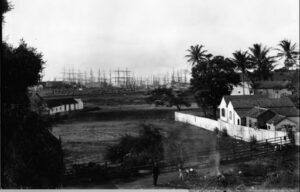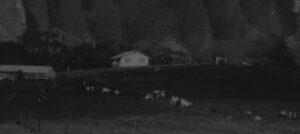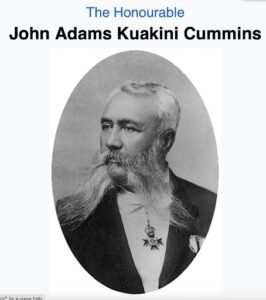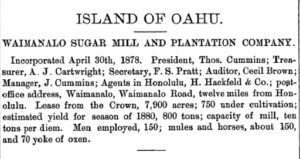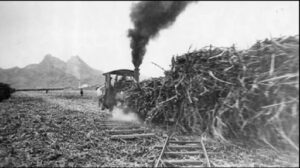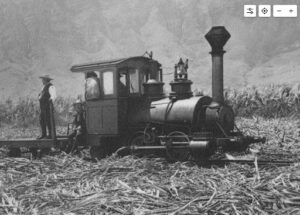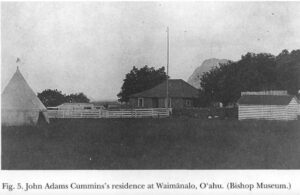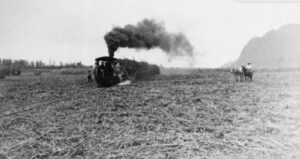The Waimanalo Sugar Plantation
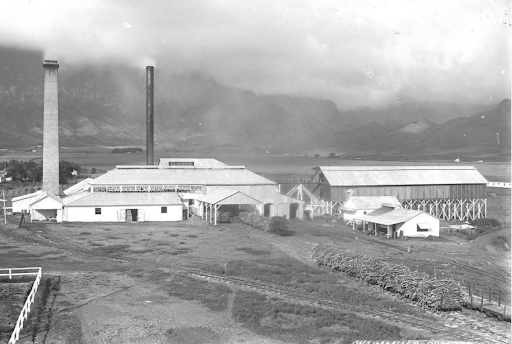
Origin and date of title photo unknown.
The story of the Waimanalo Sugar Plantation is a story of father and son: Thomas and John Cummins. Thomas Cummins was born in Lincoln, England to a wealthy British aristocratic family in 1802. When he was a young boy, his family emigrated to Halifax, Nova Scotia. In 1814, they moved again to Roxbury, Massachusetts, (a suburb of Boston), when Thomas was twelve. In 1826, when Thomas was twenty four, he boarded a ship to Hawai’i. In Hawai`i, Thomas began working with Boki, the governor of O`ahu, as a ship chandler, supplying ships with provisions, supplies and equipment. This began the close relationship of the Cummins family with Hawaiian Royalty.
The Hawaiian King at the time was Kamehamaha III, or Kauikeaouli, the longest ruling Hawaiian Monarch, who ruled from 1825 to 1854. This was the time of the seafaring trades: the Sandalwood trade, the Whaling and Sealing Trades, and trade with foreign countries such as China. Unfortunately, American merchants had convinced the Hawaiian Royalty to buy luxury goods on credit, with future payments made in Sandalwood, Hawai’i’s currency of the time. But the Sandalwood forests were rapidly depleted, leaving the Hawaiian Government in serious debt. Thomas Cummins assisted Boki and the Hawaiian Government by bringing in goods from Boston, and selling them at a profit to the many ships in port. Thomas later went into business for himself as a merchant, but “retired” from this line of work to pursue other interests.
Photo courtesy of Ulukau.com photo archives (date unknown).
In 1834, Thomas married Kaumakaokane Papali’ai’aina, a descendent of King Kamehameha I, and in 1835 she gave birth to a son, John Adams Kuakini Cummins.
Thomas Cummins first acquired interests in land in Waimanalo on March 27, 1842, when High Chief Paki leased him a parcel of land on which to build a house (a home he named Mauna Loke, or Rose Mount).
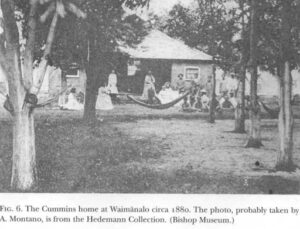
Photo courtesy of Bishop Museum Archives.
On November 25, 1850, Thomas Cummins leased 970 additional acres in the same vicinity of Waimanalo from King Kamehameha III to start a ranch. He imported heifers and bulls from California and sheep from Boston. He also had a stock ranch and bred and trained horses for racing.
Courtesy of Ulukau.org archives. Date Unknown.
Photo courtesy of evols.library.manoa.hawaii.edu “John Adams Cummins: Prince of Entertainers” by Riánna M. Williams.
Thomas Cummins’ son, John, was fifteen years old when his father started the ranch. Being half Hawaiian, John attended the Royal School, founded in 1839 by Kamehameha III for the children of Ali`i. After attending the Royal School, Cummins worked on his father’s ranch in Waimanalo, becoming manager in 1855, a position he held for some time. In 1873, John was elected by popular vote as a Representative of his Ko`olau District. He also assisted Kalakaua in effecting the Reciprocity Treaty of 1875 with the United States, making sugar production profitable in the Hawaiian Islands. The ranch was operational until 1878 when Thomas Cummins decided to lease additional lands in Waimanalo and incorporate the Waimanalo Sugar Mill and Plantation Company.
Clipping courtesy of Ulukau.org “Polk 1880: Hawaiian kingdom statistical and commercial directory and tourists’ guide, 1880/1881.”
Photo courtesy of Ulukau.org (date unknown). The mill can be seen in the distance.
The mill was built behind what is now Shima’s Supermarket. Plantation workers were brought in from Portugal and the Philippines. Tracks were laid to bring the sugar to the mill for processing, and to the wharf which was built near the end of present day Huli Street in Waimanalo (south of the HTMC Clubhouse). Ditches, reservoirs and a two mile tunnel through Mount Olomana were dug, bringing two million gallons of water per day from Maunawili to Waimanalo. The Company purchased three locomotives and one 86 food steamship to transport the sugar to Honolulu twice weekly.
Photo courtesy of Digital Archives of Hawai`i. (date unknown). The gentleman standing in the left of the photos is thought to be John Cummins.
During this time, John Cummins became known as the “Prince of Entertainers”, throwing lavish parties at Mauna Loke for Hawaiian Royalty and others. The property is said to have two Hawaiian homes (grass hale) for the exclusive use of King Kalakaua and Princess Ka`iulani.
Photo courtesy of Bishop Museum Archives (date unknown) and evols.library.manoa.hawaii.edu “John Adams Cummins: Prince of Entertainers” by Riánna M. Williams.
John Cummins also had a large clubhouse built for the plantation workers, the first clubhouse in Waimanalo!
“…building a large structure containing a reading room and a section for dances and social gatherings for the plantation laborers. It was decorated with Chinese and Japanese fans on the ceiling and pictures of King Kalakaua and other members of the royal family on the walls, and contained books, tables, an organ and singing canaries.”
Quotation courtesy of: evols.library.manoa.hawaii.edu “John Adams Cummins: Prince of Entertainers” by Riánna M. Williams.
John’s father, Thomas Cummins passed away in Waimanalo in 1885. The same year, John sold the Plantation to an agent of Claus Spreckels and began development of the “Cummins Block” in Honolulu. The Waimanalo Sugar Plantation closed its doors in 1947, marking the end of an era in Waimanalo.
Photo courtesy of Ulukau.org. (date unknown).

